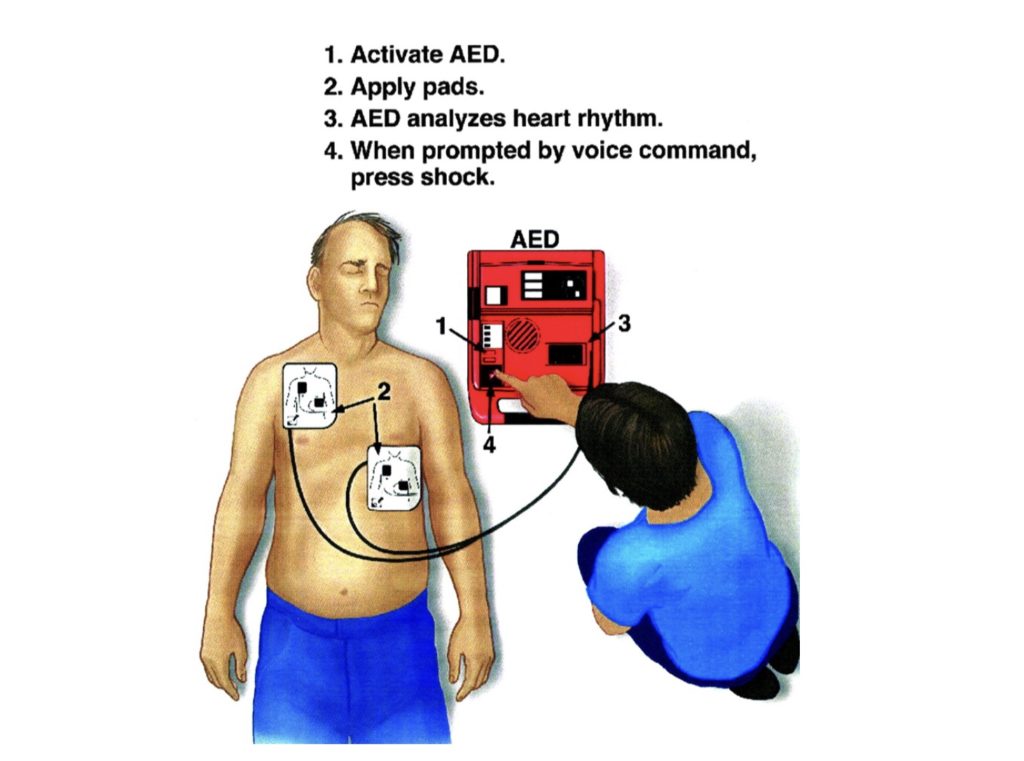1. Required Equipment
To maintain community safety, prevent serious injury, and adhere to USA Hockey rules, we require players to wear;
“gloves, shin pads, shoulder pads, elbow pads, hip pads or padded hockey pants, protective cup, tendon pads, a HECC approved helmet as designed by the manufacturer and with no alterations and chin strap properly fastened.”
“All protective equipment, except gloves, padded hockey pants, helmet/facemask and goalkeeper’s leg guards, must be worn under the uniform.”
If equipment is worn incorrectly, a referee can warn the player, stop the play or give a penalty if a player removes their equipment during gameplay, to affect gameplay.
In the MGHA, we encourage players to help educate each other and work with a captain to notify teammates or opponents. As a community, we cannot exclusively on rules and referees to keep us safe.
Read more detail and our recommendations about Required Equipment.
2. Automated External Defibrillator (AED)
This medical device is located in the Cap Ice lobby.
An AED (Automated External Defibrillator) is a portable electronic device that analyzes the rhythm of the heart and if necessary, delivers an electrical shock to help the heart re-establish an effective rhythm.
HOW TO USE:
1. If a person is unconscious, unresponsive, and not breathing, or you cannot find a pulse – immediately begin CPR.
- Stand or kneel directly over the patient’s chest. Lock your elbows and use only your upper
body weight to supply the force for the chest compressions (aim to compress 1/3 of the
victim’s chest), and count as you perform them. - Conduct compressions at a rate of 100 compressions per minute, which amounts to two
compressions per second. - Every 30 compressions, give two rescue breaths.
- Designate a person to call 911 and another person to retrieve the AED.
2. Turn on the AED and follow the machine’s prompts (the machine will guide you throughout the
process).
3. Remove the patient’s clothing to reveal a bare chest and dry the chest off if it’s wet.
4. Attach the AED pads to the patient’s chest and plug the pad cord into the machine. The pads should
have a diagram on placement. The first pad goes on the top right side of the chest. The second pad goes
on the bottom left side mid axillary, under the left breast. Make sure they adhere well.
5. The AED will analyze the rhythm of the patient’s heart. If the AED advises you to perform a shock, make sure no one is touching the patient and press the shock button.
6. Then go right back into CPR. It’s okay to perform CPR over the AED pads, so don’t worry about moving them.
7. After five cycles of CPR (30 chest compressions and 2 breaths = 1 cycle. Five cycles takes roughly 2
minutes), the AED will advise you to stand clear so it can analyze the patient again. If the AED advises
you to perform another shock, make sure no one is touching the patient and press the shock button.
8. Go right back into CPR.
9. Continue this cycle of CPR, re-analyzation, shock if machine advises it, back into CPR until help arrives or the patient is responsive and breathing normally.
10. When it comes down to it, it’s as simple as performing CPR and letting the AED do its job. Make sure a person who knows where the AED is located is present in the rink at all times. Research shows that early defibrillation is the most important single intervention. Immediate defibrillation can result in survival rates of more than 90%.
Hearts can stop for a number of reasons and not all of them will require defibrillation, but having the AED there to analyze and shock if needed is important alongside normal CPR protocols.

Sources:
https://www.youtube.com/watch?v=wAa_C0SIqiE – highly recommended visual overview
https://www.ahajournals.org/doi/10.1161/CIRCULATIONAHA.105.566851
https://www.procpr.org/training/video/adult-aed
3. Concussion Information
Concussions are serious, cumulative and a risk in hockey. Here’s what to watch out for in your teammates after any impact, particularly involving the head:
USA Hockey – Concussion Signs https://www.usahockey.com/safety-concussions:
- Appears dazed or stunned
- Is confused about assignment or position
- Forgets sports plays
- Is unsure of game, score, or opponent
- Moves clumsily
- Answers questions slowly
- Loses consciousness (even briefly)
- Shows behavior or personality changes
- Can’t recall events prior to hit or fall
- Can’t recall events after hit or fall
What happens when signs are noticed
Captains and HOps will bench skaters after a concerning impact out of an abundance of caution.
If you lose consciousness as a result of an impact, we will call your emergency contact and/or the ambulance.
Concussions alter a person’s perception temporarily and can compromise their judgment of the situation – thus the person involved is not a reliable witness. We encourage teammates to speak up on behalf of each other.
We will not require a doctor’s note to return, but we encourage you to get evaluated by a medical professional if possible and take all the time you need to return.
For more info, read the CDC website https://www.cdc.gov/headsup/index.html
